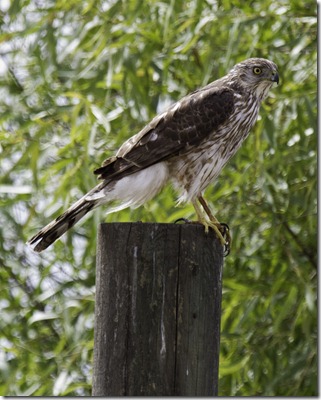Phil’s Photo Monday
Cooper’s Hawk
Cool Facts
Dashing through vegetation to catch birds is a dangerous lifestyle. In a study of more than 300 Cooper’s Hawk skeletons, 23 percent showed old, healed-over fractures in the bones of the chest, especially of the furcula, or wishbone.
A Cooper’s Hawk captures a bird with its feet and kills it by repeated squeezing. Falcons tend to kill their prey by biting it, but Cooper’s Hawks hold their catch away from the body until it dies. They’ve even been known to drown their prey, holding a bird underwater until it stopped moving.
Once thought averse to towns and cities, Cooper’s Hawks are now fairly common urban and suburban birds. Some studies show their numbers are actually higher in towns than in their natural habitat, forests. Cities provide plenty of Rock Pigeon and Mourning Dove prey. Though one study in Arizona found a downside to the high-dove diet: Cooper’s Hawk nestlings suffered from a parasitic disease they acquired from eating dove meat.
Life is tricky for male Cooper’s Hawks. As in most hawks, males are significantly smaller than their mates. The danger is that female Cooper’s Hawks specialize in eating medium-sized birds. Males tend to be submissive to females and to listen out for reassuring call notes the females make when they’re willing to be approached. Males build the nest, then provide nearly all the food to females and young over the next 90 days before the young fledge.
The oldest known Cooper’s Hawk was 20 years, 4 months old.
Habitat
Forest
Cooper’s Hawks are forest and woodland birds, but our leafy suburbs seem nearly as good. These lanky hawks are a regular sight in parks, quiet neighborhoods, over fields, at backyard feeders, and even along busy streets if there are trees around.
Food
Birds
Cooper’s Hawks mainly eat birds. Small birds are safer around Cooper’s Hawks than medium-sized birds: studies list European Starlings, Mourning Doves, and Rock Pigeons as common targets along with American Robins, several kinds of jays, Northern Flicker, and quail, pheasants, grouse, and chickens. Cooper’s Hawks sometimes rob nests and also eat chipmunks, hares, mice, squirrels, and bats. Mammals are more common in diets of Cooper’s Hawks in the West.
Nesting
Nesting Facts
Clutch Size
2–6 eggs
Number of Broods
1 broods
Egg Length
1.7–2 in
Egg Width
1.4–1.6 in
Incubation Period
30–36 days
Nestling Period
27–34 days
Egg Description
Pale blue to bluish white.
Condition at Hatching
Covered in white down and weighing just 28 grams or 1 ounce, but able to crawl around nest.
Nest Description
Males typically build the nest over a period of about two weeks, with just the slightest help from the female. Nests are piles of sticks roughly 27 inches in diameter and 6-17 inches high with a cup-shaped depression in the middle, 8 inches across and 4 inches deep. The cup is lined with bark flakes and, sometimes, green twigs.
Nest Placement
Tree
Cooper’s Hawks build nests in pines, oaks, Douglas-firs, beeches, spruces, and other tree species, often on flat ground rather than hillsides, and in dense woods. Nests are typically 25-50 feet high, often about two-thirds of the way up the tree in a crotch or on a horizontal branch.
Behavior
Aerial Forager
Cooper’s Hawks show the classic accipiter flight style: a few stiff wingbeats followed by short glides. But in pursuit of prey their flight becomes powerful, quick, and very agile, allowing the bird to thread its way through tree branches at top speed. Courting birds display by flying with slow wingbeats, then gliding with wings held in a V. Males make a bowing display to females after pairing and before beginning to build the nest.
Conservation
status via IUCN
Least Concern
Cooper’s Hawk population trends are strong today. That’s a turnaround from the mid-twentieth century, when use of the pesticide DDT and widespread shooting greatly reduced their numbers.
Source: http://www.allaboutbirds.org/guide/Coopers_Hawk/lifehistory

 (916) 434-2759
(916) 434-2759



